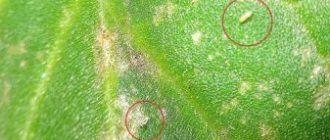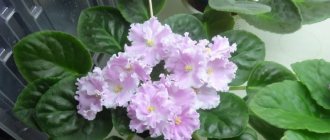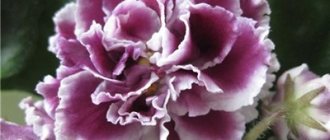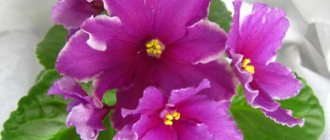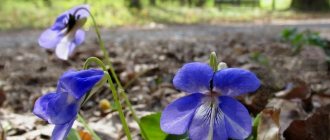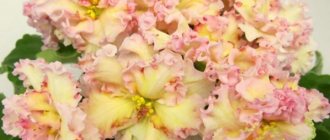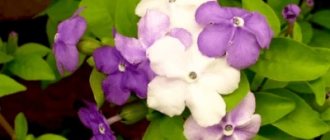Violet "Jan Minuet" is easily recognizable by its characteristic "cap" of soft pink inflorescences with a contrasting edging.
Blooms in early spring, blooms abundantly. With proper care, the continuous flowering period will be up to 10 months. This is a delicate plant that is sensitive to care conditions. Dear readers! For you, we have created communities on social networks in which useful articles and interesting ideas are published several times a day! Subscribe and receive useful content in a convenient format!
Violet, description and photo Jan-Minuet (N. Puminova)
Violets from breeders of the CIS countries - “M” (Yan).
Jan- Minuet (N. Puminova).
Ian-Minuet' (N. Puminova).
Large light pink terry stars with a crimson wavy border.
Pointed green quilted leaves. Standard. The biggest problem is that the outlet constantly keeps its hands up. An even rosette is obtained only when the violet is on the windowsill, and there is also lighting from above.
Large white-pink double and semi-double flowers with a bright crimson border. The wavy petals are not very densely spaced and add airiness to the flower. The tenderness and airiness of the flowers is given by the light pink, almost white with a pink tint, the main background of the flower, and the raspberry border-spraying along the wavy edge of the petal makes the flower bright. In varieties of different lines, as well as from flowering to flowering, the width of the border can vary. The border does not fade and the flowers last long enough.
It is most beautiful in the third flowering, the flowers become larger, fuller and brighter. The fullness of the flowers will increase if they are placed on a windowsill in spring and summer, and the age of the rosette, of course, matters. The size of the flowers is quite large, up to 6 cm. The flowers retain their freshness for quite a long time.
Abundant cap flowering, friendly opening of buds and a good bouquet. The variety is a tireless bloomer and each subsequent flowering is more abundant. It blooms often, with breaks of one month, and again with a head of flowers. Peduncles are tall, long, collected in a bouquet. There are up to 3 flowers on the peduncle.
An easy-to-care and unpretentious variety, it grows quickly, blooms quickly, and is not greedy for children. This variety needs good bright light, light for at least 12 hours a day. It grows well and beautifully only in those who have a lot of light. Likes more abundant watering than other varieties.
A variety for windowsills; when flowering on a shelf, the rosette of the paws lifts up, the flowers turn pale and do not terry at all. After abundant flowering, it likes to replant, this is necessary so that the leaves do not begin to turn yellow.
Propagates well from leaf cuttings. Babies appear quite quickly. The variety blooms early. There is a sport with curly leaves, the flowers are smaller than the variety, darker and have a brown ruffle along the edge of the petals.
The minuet is an ancient French ballroom dance characterized by smooth and slow movements and consisting mainly of bows and curtseys, as well as music to the rhythm of this dance.
Do you know that…?
You cannot use drugs of the first and second hazard classes in apartments. The toxicity of pesticide vapors in enclosed spaces is the evaporation of the drug. Penetrating into the human lungs, toxic chemicals are immediately absorbed into the blood, bypassing the liver barrier, spread throughout the body, immediately poisoning the brain and other internal organs. Every substance, even solid ones, can evaporate. The lower this indicator, the weaker the volatility, and therefore the less harmful the drug is to the lungs.
At high temperatures it evaporates faster, so in the initial period the vapor concentration will be higher, but with good ventilation in the following days the vapor concentration will already be much lower than at a lower temperature. At a lower temperature, volatility is lower, the drug also decomposes worse, which means that the dangerous concentration of vapors will stretch over a longer period.
Before you buy the violets listed below, carefully read the forums about their behavior on the windowsill. Many of them are very beautiful flowers. However, these can be large rosettes with large and fragile leaves, with leaves rising up or hugging the pot, forming many stepsons that interfere with the formation of a neat rosette, pulling the stem up and growing into a Christmas tree, bending the trunk, rare flowering with long breaks, fallen flowers or they last little and quickly wither, very long and recumbent peduncles, the color of the flower fades quickly, they do not like bright lighting on the windowsill, they are afraid of the slightest drying out or waterlogging, a large percentage of them go into sports or darken the flower.
Are they suitable for your window sill and the conditions that you can create for them? You will look at the flowers for several months, and the rosette will always be in front of your eyes. There are many beautiful flowers, there are much fewer beautiful and neat rosettes, look first at the rosette! Search and you may find a dozen violets with the same flower color if you are not interested in the smallest details as a collector.
Regulations for working with the pesticide “Preparation 30 PLUS”
The use of mineral-oil emulsions is usually associated with early spring treatments of perennial plantings against a complex of wintering pests.
The consumption rate of Preparation 30 PLUS is 500 ml. for 10 l. water, which is enough to treat about 100 m2, or 2-5 liters. per bush/tree, depending on age and crown size.
Work regulations for private household plots
Regulations for working with “Preparation 30 PLUS” for private household plots
Spraying is carried out before the buds open in the spring at a temperature not lower than +4°C in dry, windless weather
It is important to ensure uniform wetting of the trunk and branches of the plant with the working solution
As a rule, one treatment is sufficient. Repeated treatment is used in the summer, mainly for ornamental plants and conifers when “stray” scale insects of the 1st and 2nd generation appear.
Description of violet Jan Minuet
The emerald-colored leaves have a wavy border and sharp edges. In the center of the rosette flowers bloom with a terry surface, shaped like stars. They are mostly light pink with rich crimson trim of varying sizes.
The flower reaches seven centimeters in diameter. Due to the fact that the petals in the flower are not very densely arranged, the inflorescence seems light and airy. Each long and powerful peduncle produces up to three flowers.
This variety stands out clearly from other violets with its petals.
Jan-Menuet differs from other varieties of violets in its bright and more noticeable color transitions on large curly petals.
Flowers retain their freshness and presentable appearance for a long period. Usually “Jan Minuet” pleases flower growers for about nine months. There is a month break between flowering.
Each subsequent flowering is brighter and more abundant than the previous one, the flowers become larger and double. If you place this variety next to blue and ruby varieties, you will get a wonderful floral ensemble.
This variety has a small peculiarity: the violet leaves constantly stretch upward . This deficiency can be corrected by observing all necessary conditions of detention. It is necessary to maintain the correct temperature and provide the plant with vital sunlight.
The rosette of the variety will turn out even only when kept on a windowsill. If you place a pot with a plant on a shelf, the leaves will begin to stretch upward, the flowers will lose their fullness and turn pale. Sometimes additional lighting will be required to maintain an even outlet.
Appearance
The dark green leaves of the violet are slightly wavy with jagged edges. The main feature of the plant is its double flowers that resemble stars. Their color is usually soft pink, with an expressive crimson border, the width of which can vary. The diameter of the flower is on average 7 cm; there are up to 3 of them on one tall and strong peduncle in a round bouquet. Unlike other types of violets, these flowers have brighter color transitions on large and wavy petals. For about nine months they delight the eye and fill the whole house with an amazing aroma. Violets of this variety go well with blue and dark red varieties.
Home care
The variety "Jan Minuet" is considered a sensitive and delicate variety . Despite this, caring for the plant does not require much effort. Even a beginner can grow a specimen of this variety.
Lighting and temperature
The violet needs plenty of sunlight, but without direct rays, which can leave burns on the delicate leaves. “Jan Minuet” requires temperatures ranging from twenty to twenty-four degrees.
Proper temperature control is extremely important for healthy violet flowering.
The lower value is comfortable for mature plants with large flowers. Young specimens that are just gaining growth need higher temperatures.
During the winter months, a violet placed on a windowsill provides warmth.
If the plant is on a stone windowsill, the roots must be protected from freezing by using a special stand that is placed under the pot.
Watering and humidity
Water the violet regularly, preventing the substrate from drying out. There are two ways to organize watering: the method from above or from below, that is, by using a tray.
To avoid rotting, do not get water on the rosette of the flower.
The first method: carefully pour water along the edges of the pot, trying not to erode the top layer and not get on the rosette , leaves and flowers. It is most convenient to use a small watering can with a long narrow spout.
Watering is continued until water begins to pour out of the holes in the container into the pan. After half an hour, the water is removed from the pan so that it does not cause rotting of the roots.
Second method: water is poured into a tray. From there it is gradually taken away by the plant. This method has a big drawback: salts that are dangerous to the plant accumulate in the pot and are not washed out. They can lead to the death of the violet.
The correct organization of watering is checked by the appearance of the violet. A plant that receives a sufficient, but not excessive amount of moisture looks healthy: the leaves are colored rich green and feel quite elastic to the touch.
Soft, drooping leaves that hang over the edge of the planting container indicate dry soil. In such a situation, the violet needs to be urgently saved.
The pot is placed in a container with warm water so that the water reaches the middle, and placed in the shade, covered with polyethylene film. In a day the violet will return to normal .
| Seasonality of watering | |
| In summer | The violet is watered about two to three times a week, making sure that the top layer of soil dries out before the next watering. |
| in winter | the substrate is moistened less frequently, the next watering is organized only after the top soil has completely dried |
Violets of this variety are naturally found on the coasts of streams and rivers, that is, in areas with high levels of humidity.
Diseases and pests
The main reasons for the poor appearance of violets are the following infectious diseases:
- late blight;
- powdery mildew;
- gray rot;
- white rot.
The following pests cause damage to plants:
- cyclamen mite;
- whiteflies;
- mealybugs.
Effective disease prevention is regular feeding with Immunocytophyte. Insecticide treatment is recommended as the main pest control measure.
Transfer
"Jan Minuet" is recommended to be replanted in the spring. Exceptions are cases when the plant dies and urgent resuscitation .
The correct way is to transship the plant when it is replanted with an old earthen lump
To begin with, place drainage consisting of sphagnum moss or expanded clay and a little soil at the bottom of the pot. Then the violet is carefully removed from the old pot. Damaged or diseased leaves and roots are removed, excess soil is carefully removed from the earthen ball and placed in a new pot.
The violet is placed in the middle and the roots are straightened. Then the gaps between the earthen lump and the edges of the pot are filled with new soil, trying not to hit the growing point .
Temperature
Taking into account the climatic conditions existing in the historical homeland of violets, the required temperature for their successful cultivation should be from 20 to 24⁰С. The lower mark is suitable for adult specimens covered with large flowers. For young plants that are in the development stage, the temperature should be a little higher.
The Jan Minuet violet, grown on a windowsill, needs to be provided with warmth in winter. It is important to ensure that cold air does not reach the plant, especially when ventilating the room. Using a special stand for a flower pot will help to avoid hypothermia of the roots from the surface of the stone window sill.
Reproduction
Violet variety "Jan Minuet" is propagated by cuttings, leaves, peduncles or stepsons. The most common method of propagation is leaves. In spring or summer, on a healthy violet, choose a young leaf of rich color and without damage, located in the second or third row of the rosette.
The leaf is cut at an angle of forty-five degrees, and the cut area is sprinkled with activated carbon. The leaf is placed in soft water and placed in a warm room until roots form. After the roots appear, the young plant is transplanted into the soil .
Cut the propagation leaf with a sterile instrument!
Violet is a flower that is quite popular among our compatriots. Breeders even bring their unique species for sale throughout Russia. If you are interested in this home flower, we recommend reading about its history and finding out where the Violet comes from.
The variety "Jan Minuet" is quite common among flower growers and takes pride of place in collections. Delicate and beautiful flowers delight responsible owners for a long time, who comply with all the conditions necessary for the plant.
Humidity
This variety of violets grows in natural conditions mainly along the banks of rivers and streams, where the air is saturated with moisture. The humidity level for this plant should not be lower than 60%. In apartments with central heating, it is necessary to increase it in order to create a favorable microclimate for violets. This can be done in various ways:
- Place the flower pot in a flat vessel like a metal baking tray, into which pour water. As it evaporates, it will increase the humidity in the air surrounding the plant.
- Using a spray bottle, you can spray water near the plant. Due to the fact that Jan-Menuet (the violet described here) has too much pubescence, spraying the leaves and flowers is not recommended.
Jan-Minuet, N.A. Puminova
Found a mistake? Report it: 1) Select the error with the mouse 2) Press CTRL+Enter. Read more.
Violet Ya n-Menu et , N.A. Puminova
Large light pink terry stars with a crimson wavy border. Green quilted leaves. Standard. 2006 (author's description)
Ian-Minuet' (10107) 07/08/2009 (N. Puminova) Semidouble-double light pink large wavy star/thin raspberry edge. Medium green, pointed, quilted. Standard (Russ/Ukr) (AVML Catalog)
Chateau Brion
Peduncles erect, powerful. The flowers look like pompoms, large, double, and wine-colored. The edge of the petals is decorated with a wide corrugated white border. The socket is standard. The leaves are slightly wavy, elongated-ovate in shape.
Variegated
There are 3 types of variegation. The most beautiful is the type with bordering variegated leaves. In such plants, light areas are located evenly along the contour of the foliage.
The color of variegated leaves can be white, cream, white-pink, brown, grayish-pink, less often yellow, dark pink. The intensity of the variegated color depends on the conditions of the plant and the air temperature. In a cool and well-lit room, the flower becomes more vibrant. With a lack of light, the leaves become greener, and in some cases the variegation disappears entirely (during flowering). Coloring is inherited rather poorly.
With crown variegation, the center of the rosettes is colored golden, pink and white. This species is the most stable and is inherited.
Rows of green foliage alternate with colored ones. During the flowering period, in most varieties the center of the rosettes turns green.
A more stable type is mosaic variegation. The foliage of such violets is partially or completely covered with an irregular, intricate pattern, similar to a pattern on marble or a mosaic of cream, pink, streaks and spots. This type of violet is quite rare.
Another type is known, this is spontaneous variegation. These plants do not transmit variegation from the parent varieties.
Summer twilight
The flower has the correct proportions. Flowering is quite abundant. The inflorescences are large, semi-double, contrasting. The background color of the petals is lilac-violet. The edges are trimmed with white ruffle. The leaves are variegated, slightly concave. The edges are slightly wavy. The rosette is smooth, spherical in shape.
Blue Dragon
The flowers are large, pale blue. The edge of the petal has a white-green border. The socket is powerful and flat. The leaves are dark green in color, with a crimson or purple tint on the underside. The variety is grown on a well-lit windowsill or loggia.
South night
The variety has dark blue simple star-shaped flowers with bright crimson fantasy peas and a thin white border. The foliage is dark green with pink splashes. The socket is smooth, standard sizes.
Chic poppy
This is a variegated plant with double, large-sized flowers with a wavy, fringed edge. The flowers reach 6 centimeters in diameter. The edges of the petals are dimpled, similar to ruffles. The coloring of the petals is excellent, from light pink to orange-red tones. The leaves are pubescent, spade-shaped, decorative. Light greens from the center become discolored and turn into white tones, making them variegated. At times the leaves become completely white.
Properties
Name
- Original: Jan-Minuet
- Transcription:
- Translation:
Registration
- Selection: N.A. Puminova
- Year: 2006
Socket
- Socket type: standard
Flower
- Flower size, up to: 7 cm
- Flower shape: star
- Terry size: semi-double, terry
- Main color: light pink
- Type of painting: two-tone
- Border: plain
- Other features:
Foliage
- foliage color: medium green
- foliage type: simple
- foliage shape: pointed, heart-shaped; quilted
- reverse of sheet: silver
- leaf edge: jagged edge
- variegation:
Meet Lituanica
The trailer violet of the Lithuanian selection Lituanika is famous for its large, densely double inflorescences with slightly elongated petals, reminiscent of small dahlias in shape. The color of the flowers is noteworthy - pink-peach. The edges of the petals are colored more intensely, which adds an exquisite decorative effect to the plant.
The rosette is also decorated with dark green, densely pubescent, pointed leaves. The elongated stem and side shoots provide generous flowering of the bush, which grows quite quickly
Note that an important place in increasing the decorative value of a crop is occupied by a flower stand, demonstrating the most favorable angles of the bush and installed in the most comfortable conditions - where direct sunlight does not penetrate, but soft diffused light is sufficient. Lituanica forms a rather tall, well-leafed rosette and can grow to impressive sizes. Therefore, you should think about what the flower stand will be like in advance.
Therefore, you should think about what the flower stand will be like in advance.
Peculiarities
Quite a popular variety and beloved by many collectors. The flowers of this variety are delicate, airy and bright at the same time. The tenderness and airiness of the flowers is given by the light pink, almost white with a pink tint, the main background of the flower, and the raspberry border-spraying along the wavy edge of the petal makes the flower bright. In varieties of different lines, as well as from flowering to flowering, the width of the border may vary. The flower shape is a double star. When fully bloomed, the flower size reaches 7 cm. There are up to three flowers on the peduncle. The peduncles are tall, quite strong, collected in a bouquet. The variety blooms early, blooms often and abundantly. Flowers retain their freshness for quite a long time.
An even rosette of quilted medium green leaves. The big drawback of this variety is its need for a balance of adequate light and cool temperatures. The leaves of the rosette pull “hands up” both in good lighting, but elevated temperature on the shelf, and in lack of light, but comfortable temperature on the windowsill. In order for the outlet to be smooth and not pull “hands up”, good daylight and coolness are preferable. Otherwise, the variety is easy to care for. Propagates well from leaf cuttings. The babies grow quickly and bloom early. Sports are very rare. Beginning collectors need to take into account the features of this variety in order to form a good rosette.
Energy of color
The popularization of violets has been in full swing lately. Thanks to the efforts of breeders, more and more people are decorating their homes with Saintpaulia. Beginning collectors are often afraid of failure when purchasing a particular variety.
The lilac violets described in the article are suitable for both beginners and experienced gardeners. What attracts these plants and why are they so popular?
The color range of lilac shades is large. There are not many of them in nature. Therefore, violets bred by creative and extraordinary people help bring harmony to the space of the house. It's warmer and more comfortable with them.
From all the variety of shapes - pansies, stars, bells, bowls, wasps - you can choose the one that suits you.
Terry, semi-double, simple, in the form of carnations or scalloped, with a border, fringe - they are equally beautiful and unique.
Lilac violets are fascinating, they have a mysterious energy that makes you kinder and calms you down. Chimeras and Saintpaulias with prints leave no one indifferent.
Important! It turns out that anyone can find a lilac Saintpaulia to their liking or create their own unique collection.
Reviews
Alina Akzigitova. I’ve only recently acquired this variety, but it’s already one of my favorites. In my conditions of an eastern window and long daylight hours, the rosette begins to “hugging” the pot. The socket is still young, the starter. The first flowering in the extreme heat this summer is not a bouquet. But we will wait for the hat, I hope. I noticed that it differs from other varieties - it likes to drink more than others. One photo, but what kind is there?
.
- Login or register to post comments
Playback
Typically, the “Yang ornate” violet is grown vegetatively – in leaves. Using this method, the young flower will inherit the properties of the mother plant.
The leaf is taken in the spring. Cut off the petiole by three to four centimeters and plant it in peat soil. The sheet does not need to be buried; it must remain completely on the surface. Make sure the soil has a low degree of moisture. The temperature should be maintained at 18-22 °C. In a month and a half, new leaves of the young violet will appear. Remove the leaf that gave rise to the plant. When the young violet grows up, it is transplanted into a larger pot. You can root the leaf in water, but this method increases the possibility of rotting.
When the rosette of leaves becomes three times wider than the pot, the violet needs to be replanted. 9-12 months pass from the day the leaf is planted until the first flowering.
Comments
A big request to the owners of this variety! Please add your photos and write reviews. The variety is no longer new, but still remains interesting and popular. In addition, the variety is not very simple. I would like to collect more information here about the successes and failures in growing this variety. In order to add your photos, you need to click on the word “Edit” in the very top line above the article. And then everything is the same as in writing a regular article. Add a photo. In the “Reviews” section, write your impressions about the variety. And don't forget to save the added information. Thanks in advance everyone!
Watering
What is special about fairy tale raspberries: photo of the variety with description, rules of care and cultivation
To successfully grow this crop, it is necessary to provide regular watering to prevent the earthen clod from drying out. This can be done in two ways - from above or from below (from the pallet). In the first case, water is poured near the edge of the pot in such a way as not to erode the surface of the soil and not to wet the young tender leaves of the plant.
When watering from below, water is poured into a tray, from where it is gradually absorbed by the plant. This method has a significant disadvantage - harmful salts accumulate in the earthen coma over time, which can cause the flower to wither.
For irrigation, ordinary tap water is used, which is left to settle in an open container for two days.

